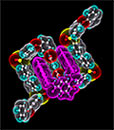Chemists from the University of Reading (Reading, United Kingdom) have prepared an artificial form of DNA that could revolutionize the way we process and store digital information.

A new paper, appearing in the scientific journal Nature Chemistry, demonstrates for the first time ever that many of the features of biological information processing can be replicated into synthetic polymer chains.
The research team, led by Howard Colquhoun, professor of materials chemistry in the Department of Chemistry, designed and synthesized short sequences of polymers that store information within them. In the long run, researchers believe that this could spark a future revolution in the field of numerical (digital) information. Systems of artificial polymers will be able to lead to information compression that will be several million times higher than that found in existing systems.
An essential element for the success of the study was the preparation of tweezer-shaped furrows that are able to select a certain piece of information along the polymer chain and bind to it. The two arms of the tweezers "feel" the different sequences with which they react and then tighten to those areas with the greatest structural compatibility along the chain.
A number of such tweezer-like beads can join one another across the polymer chain, which allows them to "read" and "translate" the information stored in the long-range and extensive sequences in the polymer.
The interesting finding is that different types of frogs start reading at different points on the chain. This selectivity means that different types of information can be decoded from the same sequence, which increases the amount of information available.
The lead researcher notes: "This type of process is parallel to the process of processing genetic information. In the future, we plan to develop methods for "writing" new information inside the polymer chains, with our long-term goal being the development of a completely synthetic information technology that works at the molecular level."

2 תגובות
interesting.
LIKE